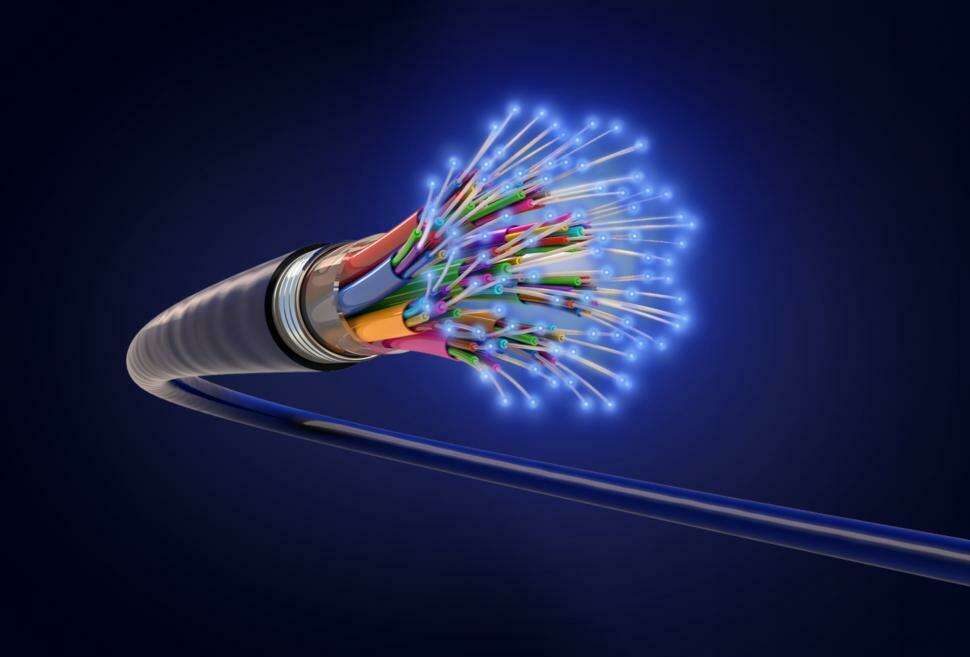A Beginner’s Guide to Understanding Fiber Optics Technology

Strong 8k brings an ultra-HD IPTV experience to your living room and your pocket.
In today’s fast-paced digital world, having reliable, high-speed internet is no longer a luxury but a necessity for both businesses and individuals. Whether it's for seamless video conferencing, quick file sharing, or uninterrupted streaming, fiber optics technology has emerged as the solution to meet the growing demand for high-speed internet. But what exactly is fiber optics, and why is it becoming increasingly popular? This article will provide you with a comprehensive guide to understanding fiber optics, from how it works to its benefits and applications.
According to Persistence Market Research, the global fiber optics market size is expected to grow from US$ 7.7 billion in 2025 to US$ 15.8 billion by 2032, with a compound annual growth rate (CAGR) of 10.7%. This rapid growth reflects the increasing importance of fiber optics in driving global connectivity and communication.
What is Fiber Optics?
At its core, fiber optics refers to the technology used to transmit data as light signals through thin strands of glass or plastic fibers. These optical fibers are capable of carrying large amounts of data over long distances with minimal loss of quality or speed. Fiber optics are fundamentally different from traditional copper-based wiring (such as coaxial cables or telephone lines) because they use light instead of electrical signals to transmit information.
The main components of a fiber optic system include:
- Optical Fibers: These are the thin strands made of glass or plastic that carry the light signals.
- Transmitter: This component converts electrical signals into light signals.
- Receiver: The receiver converts the light signals back into electrical signals.
- Fiber Optic Cable: These cables are made up of many optical fibers bundled together and are designed for installation in various environments, whether underground or overhead.
The technology behind fiber optics has revolutionized telecommunications, enabling faster and more reliable data transmission. Fiber optics are commonly used in internet connections, television services, and telecommunications networks.
How Does Fiber Optics Work?
Fiber optics work by transmitting data in the form of light signals through an optical fiber. The light signals travel at incredibly fast speeds, often close to the speed of light, ensuring quick data transfer across great distances. Here’s a basic overview of how the process works:
- Signal Conversion: The data, which may come in the form of digital information (like videos, emails, or web pages), is first converted into light signals by a transmitter.
- Light Transmission: The light signals travel through the optical fiber, which has a central core made of glass or plastic. The core is surrounded by a cladding that reflects the light back into the core, allowing the light to travel long distances with minimal signal loss. This is known as total internal reflection.
- Signal Reception: Once the light signals reach their destination, the receiver converts them back into electrical signals, which can be interpreted by the receiving device, such as a computer or smartphone.
Types of Fiber Optics
There are two primary types of fiber optic cables: single-mode fiber and multi-mode fiber. Understanding the difference between these two is essential when choosing a fiber optic solution for specific applications.
Single-Mode Fiber
- Definition: Single-mode fiber (SMF) has a very small core, typically around 8 to 10 microns in diameter, which allows only one light signal to pass through at a time.
- Distance: This type of fiber is designed for long-distance communication. The light signal travels in a straight line without much dispersion, allowing it to cover greater distances without signal loss.
- Applications: Single-mode fiber is often used in telecommunications networks, large-scale data centers, and internet backbones where long-distance transmission is necessary.
Multi-Mode Fiber
- Definition: Multi-mode fiber (MMF) has a larger core (50 to 100 microns in diameter), allowing multiple light signals to travel simultaneously through the fiber.
- Distance: Multi-mode fiber is designed for shorter distances as the multiple signals tend to spread out, leading to higher levels of signal loss over long distances.
- Applications: Multi-mode fiber is often used in local area networks (LANs), data centers, and within buildings or campuses where high-speed data transmission is needed over shorter distances.
Advantages of Fiber Optics
Fiber optics offer a range of advantages over traditional copper-based cables. The key benefits include:
- High-Speed Data Transfer: Fiber optic cables can transmit data at much higher speeds compared to copper cables. This is one of the main reasons why fiber optics are preferred for high-speed internet connections, video streaming, and large-scale data transmission.
- Increased Bandwidth: Fiber optics provide significantly higher bandwidth capacity, meaning they can carry more data at once. This is essential for businesses that need to support multiple users or high-demand applications.
- Low Latency: Fiber optics have extremely low latency, meaning the time taken for data to travel from one point to another is minimal. This is critical for real-time applications, such as video conferencing, online gaming, and VoIP calls.
- Greater Reliability: Fiber optic cables are less susceptible to electromagnetic interference (EMI) and radio frequency interference (RFI), which can disrupt data transmission in copper cables. This makes fiber optics more reliable, especially in environments with high electrical interference.
- Longer Distances: Fiber optic cables can transmit data over much greater distances than copper cables without losing signal quality. While copper cables typically need repeaters for long distances, fiber optics can maintain signal strength for many kilometers, making them ideal for long-haul data transmission.
- Security: Fiber optics offer higher security than traditional copper cables. It is difficult to tap into a fiber optic cable without being detected, making it a more secure option for sensitive data transmission.
- Durability and Longevity: Fiber optic cables are more durable and have a longer lifespan compared to copper cables. They are less prone to corrosion and can withstand harsher environmental conditions, making them a more sustainable long-term investment.
Applications of Fiber Optics
Fiber optics technology has a wide range of applications, spanning across various industries. Some of the most common uses include:
- Internet and Broadband: Fiber optic cables are increasingly used to provide high-speed internet connections to homes and businesses. Fiber-to-the-home (FTTH) and fiber-to-the-premises (FTTP) are two common examples of how fiber optics are delivered directly to users.
- Telecommunications: Fiber optics are the backbone of modern telecommunications networks, enabling high-speed voice and data transmission over long distances. This technology supports everything from traditional phone calls to mobile data services and global internet traffic.
- Medical Field: Fiber optics are used in medical imaging, such as endoscopes, which allow doctors to look inside the body with minimal invasiveness. Fiber optics are also used in medical instruments that require high precision.
- Fiber optics play a critical role in television and radio broadcasting, allowing for the transmission of high-definition video and audio over long distances without signal degradation.
- Industrial and Military Applications: Fiber optics are used in various industrial and military settings for secure and reliable communication systems. They are also employed in sensors and other monitoring equipment that require precision and durability.
- Data Centers and Cloud Computing: Fiber optics are essential in data centers, enabling fast and reliable data transmission between servers and storage systems. As businesses increasingly rely on cloud computing, fiber optics are key to ensuring high-speed access to cloud services.
Fiber Optics vs. Copper Wiring: A Comparison
While fiber optics offer numerous advantages, it is essential to compare them with traditional copper wiring to fully understand their impact.
- Speed: Fiber optics provide much faster data transfer speeds than copper cables, making them ideal for high-demand applications such as video streaming and cloud computing.
- Bandwidth: Fiber optics can handle significantly more bandwidth than copper cables, which makes them better suited for businesses and organizations that require high-capacity networks.
- Distance: Fiber optics can transmit data over much longer distances without losing signal strength, unlike copper cables, which require repeaters for long-distance transmission.
- Security: Fiber optics offer enhanced security over copper cables since they are more difficult to tap into without being detected.
- Cost: Although fiber optics come with higher installation costs, they provide long-term savings due to their reliability, durability, and lower maintenance needs.
Future of Fiber Optics
As the demand for faster internet speeds and more reliable connectivity continues to grow, the future of fiber optics looks promising. With advancements in technology, fiber optic cables are becoming more affordable and accessible. Many cities around the world are already rolling out fiber optic networks to provide faster internet to homes and businesses. As the digital economy expands, fiber optics will play an increasingly critical role in supporting communication, data transfer, and online services.
Conclusion
Fiber optics are transforming the way we communicate, work, and access the internet. Whether you’re a business owner looking for faster and more reliable internet or someone curious about how fiber optics work, understanding this technology is essential. The speed, reliability, and future-proof nature of fiber optics make it the backbone of modern communication systems. As more industries adopt fiber optics for data transmission, its importance will only continue to grow, revolutionizing how we stay connected in the digital age.
Note: IndiBlogHub features both user-submitted and editorial content. We do not verify third-party contributions. Read our Disclaimer and Privacy Policyfor details.







